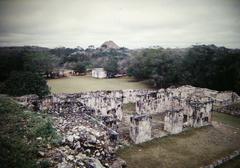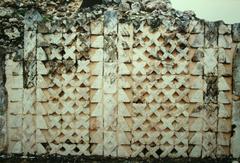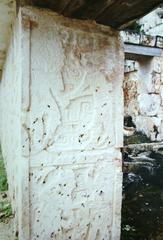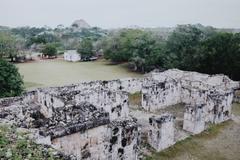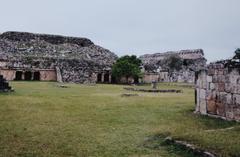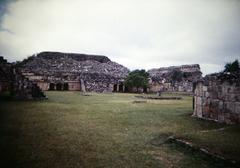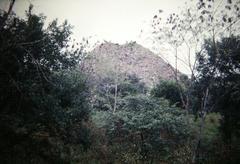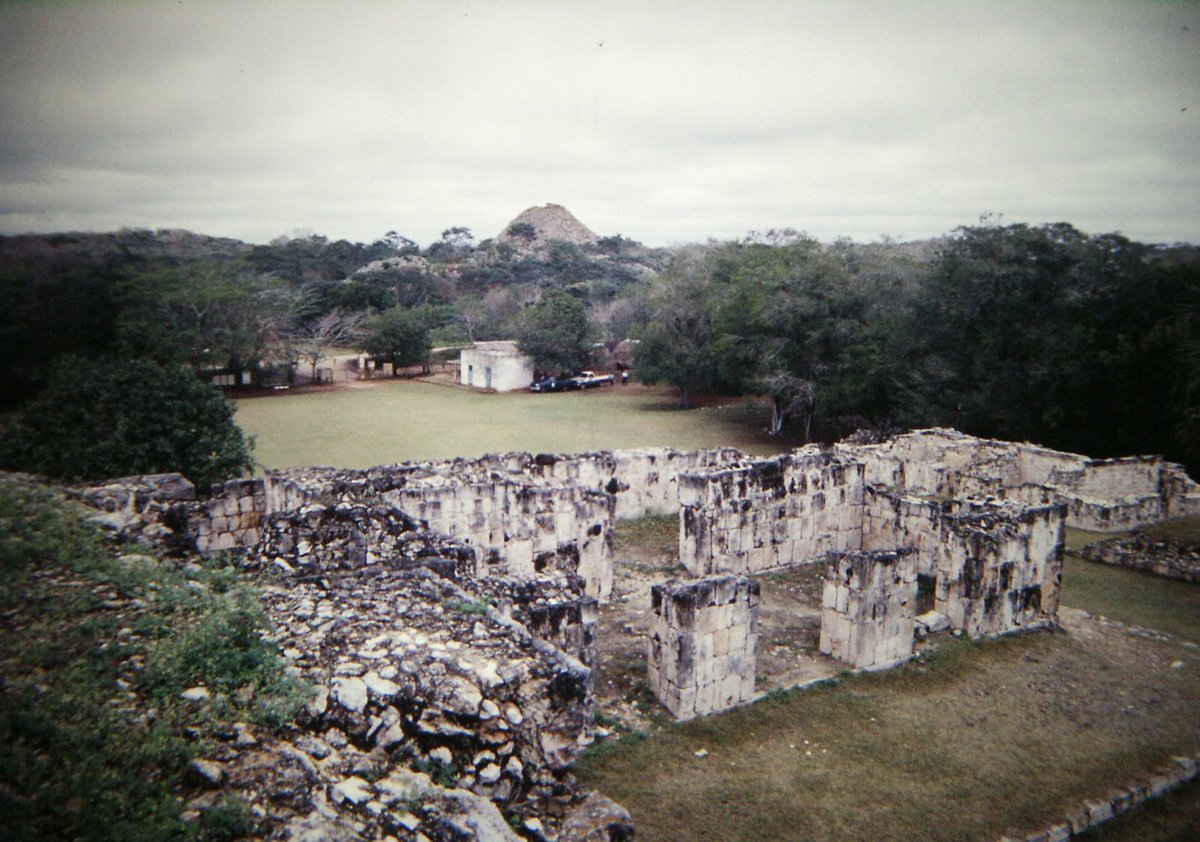
Kabah Visiting Hours, Tickets, and Tourist Guide: Santa Elena Historical Site
Date: 14/06/2025
Introduction to Kabah Historical Site in Santa Elena
Nestled in the Puuc region of western Yucatán, Mexico, the Kabah Archaeological Site is a remarkable testament to the ingenuity and artistry of the ancient Maya civilization. Renowned for its Puuc architectural style, Kabah is home to the iconic Palace of the Masks (Codz Poop), adorned with hundreds of stone masks representing Chaac, the rain god. The site’s name, meaning “strong hand” in archaic Maya, reflects its historical role as a political and religious center during the Late Classic period (c. 600–900 AD). Visitors today can explore Kabah’s ceremonial plazas, monumental arch, and the sacbé (stone causeway) that once linked it to Uxmal, immersing themselves in a landscape that embodies both spiritual and practical responses to the region’s challenging environment (Adept Expeditions; Tren Maya; Lonely Planet).
This comprehensive guide offers everything you need to plan a visit—from historical background and architectural highlights to practical visitor tips, accessibility information, and advice on combining Kabah with other sites along the Puuc Route. Whether your interest lies in Maya art and cosmology or in discovering a tranquil, less crowded destination, Kabah is a must-see on any Yucatán itinerary (Drive Mexico Magazine; Charco Trip).
Table of Contents
- Introduction to Kabah Historical Site
- Historical Context
- Architectural Features and Innovations
- Artistic and Decorative Elements
- Kabah’s Role in the Puuc Route
- Visitor Information
- On-Site Experience: Atmosphere and Ambiance
- Practical Visitor Tips
- Site Layout and Navigation
- Recommended Duration and Itinerary Planning
- Site Rules and Visitor Etiquette
- Insider Tips
- Frequently Asked Questions (FAQ)
- Conclusion and Call to Action
- Visuals and Interactive Resources
- References
Historical Context
Origins and Urban Development
Kabah’s origins date back to the mid-3rd century BCE. It flourished as a major Maya city between the 7th and 11th centuries CE, with its peak marked by inscriptions from 879 CE and evidence of activity until at least 987 CE. The name “Kabah” is interpreted as “strong hand,” and alternative readings such as “Kabahaucan” (“royal snake in the hand”) attest to its cultural significance (Tren Maya). The city was strategically connected to neighboring centers, most notably Uxmal, via an 18-kilometer sacbé.
Social and Religious Significance
Kabah’s ceremonial core and residential compounds suggest a society organized around extended families, with close ties to other Puuc sites like Sayil and Labná. The omnipresence of Chaac masks in Kabah’s architecture reflects the critical importance of rain and water management in this drought-prone region.
Decline and Rediscovery
Construction at Kabah ceased by the late 10th century CE, well before the Spanish arrival. Rediscovered in the 19th century by explorers such as John Lloyd Stephens and Frederick Catherwood, Kabah gained UNESCO World Heritage status as part of the Puuc region in 1996.
Architectural Features and Innovations
Puuc Style and Urban Planning
Kabah exemplifies the Puuc architectural tradition, characterized by finely cut limestone veneer, intricate mosaic stonework, and elaborate friezes, especially on upper facades. The city is divided into architectural groups:
- East Group: Features the Palace of the Masks, Royal Palace, and Temple of the Columns.
- Central Group: Located across Highway 261, includes the Quadrangle, Great Pyramid (Teocalli), and ceremonial Arch.
Sacbeob (white roads) connected Kabah to Uxmal and other towns, highlighting both political and ritual unity (Adept Expeditions).
Palace of the Masks (Codz Poop)
The Codz Poop is Kabah’s most famous structure, with over 250 stone masks of Chaac on its façade. This display not only underscores the city’s dependence on rain but also showcases the technical mastery of Puuc architects. The building’s layout and orientation suggest its central role in ceremonies (Tren Maya).
The Arch of Kabah
Dating to the Early Puuc period (670–770 AD), the ceremonial arch marks the start of the sacbé to Uxmal. Its simple elegance and faded red handprints evoke ancient rituals and the importance of passage between the sacred and profane.
Other Key Structures
- Temple of the Columns: Not open to the public, but notable for its colonnaded façade.
- Royal Palace: Likely served as a seat of governance for elite residents.
- Great Pyramid (Teocalli): A probable “House of the Gods” used for ritual functions.
Water Management
Ingenious water storage solutions, such as chultunes (underground cisterns), were essential for survival in the Puuc hills. These features highlight the Maya’s adaptation to their environment (Tren Maya).
Artistic and Decorative Elements
Kabah’s artistic achievements include:
- Mosaic Stonework: Geometric patterns, lattices, and stylized deities.
- Stelae and Altars: Monuments celebrating rulers and ceremonial events.
- Glyphic Inscriptions: Offer insights into Kabah’s history and political alliances (Adept Expeditions).
Kabah’s Role in the Puuc Route
As a principal city along the Puuc Route, Kabah is part of a network of sites with shared architectural and cultural traits, including Uxmal, Sayil, and Labná. Its sacbé connection to Uxmal and similarities in style suggest Kabah was an allied or vassal center within a complex system of Maya city-states (Wikivoyage). Today, the Puuc Route remains a popular focus for both research and cultural tourism.
Visitor Information
Visiting Hours
- Open daily: 8:00 AM to 5:00 PM (last entry at 4:00 PM).
- Early morning and late afternoon visits are recommended to avoid heat and crowds (Charco Trip).
Tickets and Admission
- General admission: 80 MXN (~$4.80 USD; may vary slightly).
- Discounts: Free for Mexican citizens and Yucatán residents on Sundays (with ID); children under 13 free daily.
- Purchase: At the entrance ticket office; online sales are not yet standard (Charco Trip).
- Multi-site passes: Available for Puuc Route sites.
Accessibility
- Terrain is mostly flat but includes steep stone stairs; not wheelchair accessible.
- Comfortable walking shoes are essential; those with mobility concerns should plan accordingly.
Getting There and Accommodation
- By car: Approximately 1.5 hours (104 km) south of Mérida via Highway 261; free parking available (Mexico Cenotes and Ruins).
- By bus: Sur buses from Mérida serve Kabah and other Puuc Route sites (up to five times daily).
- Tours: Guided day tours from Mérida or Uxmal frequently include Kabah.
- Nearby lodging: Santa Elena (8 km north), Ticul, Muna, and Oxkutzcab offer accommodation. Mérida is ideal for those seeking broader amenities.
Guided Tours and Events
- Local guides are available at the entrance, offering tours in Spanish and sometimes English.
- Occasional special events and workshops are hosted onsite.
Photography Tips
- The Palace of the Masks is best photographed in soft morning or late afternoon light.
- Drones are generally prohibited; check current regulations at the entrance.
On-Site Experience: Atmosphere and Ambiance
Kabah provides a tranquil, uncrowded alternative to major sites like Chichén Itzá. The lush surroundings, overgrown ruins, and peaceful setting offer a contemplative atmosphere ideal for both exploration and photography (Drive Mexico Magazine).
Practical Visitor Tips
- Best time to visit: Dry season (December–April) is most comfortable, but November and early December offer a good balance of weather and fewer crowds.
- What to bring: Water, sun protection (hat, sunscreen), insect repellent, camera, lightweight clothing, and a small backpack.
- Facilities: Restrooms and souvenir vendors are located at the entrance. Only water is allowed inside the ruins; food, alcohol, and pets are prohibited (Mexico Cenotes and Ruins).
Site Layout and Navigation
- The main restored area is east of Highway 261, featuring the Codz Poop and Palace. The west side is overgrown, good for birdwatching and seeing unrestored ruins (Yucatán Magazine).
- Information panels in Spanish, English, and Maya aid self-guided tours.
Recommended Duration and Itinerary Planning
- Expect to spend 1–1.5 hours at Kabah; up to 2 hours if exploring both sides of the highway.
- Combine with Uxmal and other Puuc Route sites for a full-day or multi-day itinerary (Exploration Vacation).
Site Rules and Visitor Etiquette
- No food, alcoholic beverages, or pets inside.
- Smoking is prohibited.
- Climbing on monuments is generally not allowed; heed signage.
- Respect restoration areas and ongoing archaeological work.
- Follow any public health guidelines in effect.
Insider Tips
- Arrive early for cooler temperatures and fewer visitors.
- Bring cash for fees, souvenirs, and tips.
- Watch for birds and other wildlife in less-restored sections.
- Check for new openings or special events (The Mayan Ruins Website).
Frequently Asked Questions (FAQ)
What are Kabah’s opening hours?
8:00 AM to 5:00 PM daily (last entry 4:00 PM).
How much are tickets?
80 MXN for adults; free for Mexican citizens and Yucatán residents on Sundays with ID; children under 13 enter free.
Is Kabah wheelchair accessible?
No; uneven terrain and stairs limit accessibility.
Can I buy tickets online?
Currently, tickets are sold only at the entrance.
Are guided tours available?
Yes; local guides offer tours in Spanish and sometimes English.
Conclusion and Call to Action
Kabah is a serene, historically rich destination offering a deep connection to Maya heritage through its remarkable architecture, tranquil setting, and ongoing archaeological discoveries. For a meaningful experience, plan your visit early, consider a guided tour, and take time to explore both the restored and natural sections of the site. Combine Kabah with other Puuc Route sites for a comprehensive journey into ancient Maya civilization.
Download the Audiala app for maps, audio tours, and the latest updates on Yucatán’s archaeological sites. Follow us on social media for travel inspiration and real-time tips to enrich your adventure.
